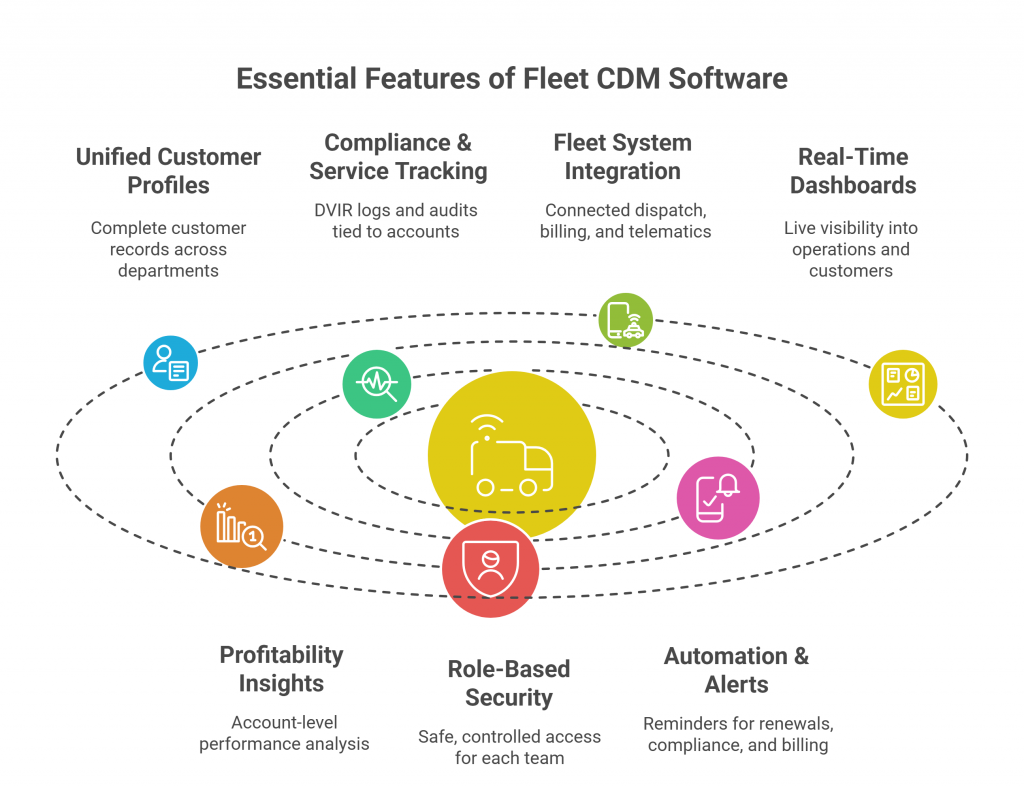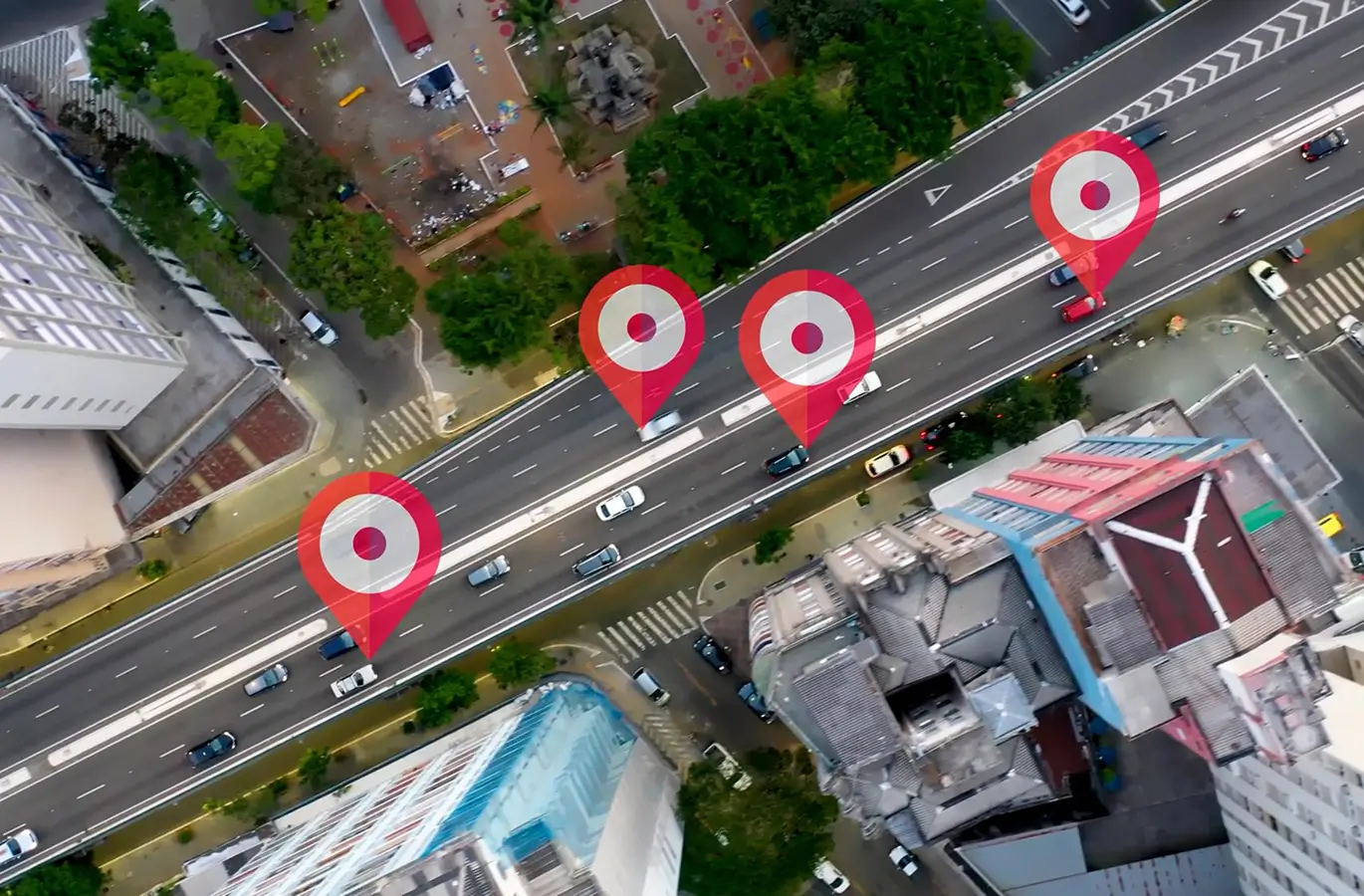Fleet and logistics operators know the value of precision. Vehicles are tracked by the mile, service schedules are monitored daily, and compliance records are kept ready for inspection.
Yet when it comes to customer data, many companies still depend on scattered spreadsheets, disconnected CRMs, and manual updates. This imbalance creates risk: trucks may run on time, but customer relationships often lag.
Customer Data Management (CDM) software is designed to fix that gap. It consolidates contracts, compliance records, service histories, and billing details into one platform that every team can access. For fleet businesses, this means fewer errors, stronger retention, and decisions based on facts instead of guesswork.
But not all CDM software is built for fleets. Some tools focus on marketing, others on sales, and many overlook the operational realities of logistics. That is where REACH stands apart. By combining compliance-first workflows, service digitization, and uptime monitoring with accessible customer records, REACH demonstrates what matters most in a CDM solution tailored for fleets.
This article examines the key features that define customer data management tools, compares how various software categories deliver on these features, and demonstrates how fleets can select the ideal platform to support their growth.
More than a checklist, it is a guide to building stronger customer relationships with the same discipline fleets already apply to vehicle management.
Why Customer Data Tools Are Critical in Fleet and Logistics
Fleet and logistics companies operate in one of the most data-heavy industries. Every trip generates dispatch notes, compliance logs, fuel charges, and service records. At the same time, every customer generates contracts, billing details, and communication threads. Without a system to connect the two, teams work in silos and struggle to form a clear view of the business.
The consequences are serious. Scattered customer data leads to missed renewals, compliance gaps, duplicate billing, and poor visibility into which accounts drive profit or create losses. Operations teams often focus on vehicles while overlooking the customer experience that sustains long-term growth.
Generic data management software rarely solves this problem. Many platforms are built for marketing or sales pipelines, rather than for fleets, where compliance, uptime, and service records are inseparable from customer relationships. What a logistics operator needs is a tool that links customer accounts with operational data in real time.
This is why customer data tools purpose-built for fleets are critical. They ensure that service history is tied to customer records, compliance logs are available during audits, and contract renewals are never missed.
Platforms like REACH demonstrate how this works in practice. By digitizing service workflows and connecting DVIR compliance data with customer accounts, REACH gives fleet teams an operationally relevant view of their customers.
When customer data is managed with the same discipline as fleet data, businesses reduce risk, improve retention, and unlock new growth opportunities.
Core Features That Define CDM Software
Customer Data Management (CDM) software is only valuable if it solves the real challenges fleets face: fragmented records, compliance complexity, and customer churn. The right platform does more than collect information. It transforms customer data into an operational asset that informs decision-making and fosters stronger, more meaningful relationships. Below are the features that matter most.
1. Unified Customer Profiles
Every fleet interacts with customers across multiple touchpoints: dispatch, billing, compliance, and service support. Without a unified system, each department maintains its own version of the customer record. This leads to duplication, errors, and missed opportunities. A CDM tool consolidates everything into a single profile. For example, REACH provides unified customer records that combine service requests, DVIR reports, and contract details, giving every department the same view of the customer.
2. Compliance and Service History Tracking
For fleets, compliance is not optional. CDM software must connect customer accounts to DVIR inspections, maintenance logs, and safety reports. This ensures that during audits or contract renewals, accurate records are instantly available. REACH strengthens this link by digitizing service workflows and tying compliance data directly to customer profiles, reducing the risk of fines or penalties.
3. Integration With Fleet Management Systems
A standalone CDM tool has limited value if it cannot integrate with existing systems. Dispatch tools, billing software, and telematics platforms all generate data that shapes the customer relationship. The best CDM solutions integrate seamlessly, creating an ecosystem where information flows both ways. REACH is designed with this integration mindset, ensuring that customer records reflect operational realities in real-time.
4. Real-Time Data Visibility
Customer data must be actionable. Real-time dashboards enable managers to view active service requests, billing status, and compliance alerts in real-time, eliminating the need for manual updates. This speed enables proactive problem-solving, such as notifying a customer about a potential delay before it escalates into a more significant issue. With REACH, real-time visibility is paired with automated notifications, keeping both teams and customers aligned.
5. Profitability and Account Insights
Not all customers are equally valuable. Some accounts deliver steady revenue with minimal support, while others drain resources through repeated service demands. CDM software should provide profitability insights at the account level, showing which relationships strengthen the business and which require renegotiation. By analyzing these metrics, fleets can focus resources where they deliver the greatest return.
6. Role-Based Access and Security
Customer data often includes sensitive financial and compliance information. A robust CDM platform must offer role-based access, allowing each department to view only what it needs. For example, finance staff may access billing details while service teams focus on maintenance logs. REACH supports this principle by allowing secure collaboration without compromising data integrity.
7. Automation and Alerts
Manual processes waste time and create risk. A CDM tool should automate reminders for contract renewals, compliance checks, and overdue payments. Alerts keep teams informed and customers engaged. Automation also reduces reliance on memory or spreadsheets, ensuring nothing slips through the cracks.
7 Must-Have Features in Customer Data Tools

Comparing CDM Software: Features That Matter Most
Customer data management tools are not all created equally. Some are designed for marketing teams, others for sales, and only a few align with the operational complexity of fleets and logistics. To choose wisely, businesses must compare software categories based on how they deliver the features that truly matter.
Fleet-Focused CDM Platforms
These tools are purpose-built for fleets. They prioritize compliance logs, service histories, and integration with dispatch systems. For example, REACH goes further by digitizing service workflows, tying DVIR compliance records to customer accounts, and ensuring uptime data flows into customer profiles. This makes it the most aligned option for fleets where compliance and service define customer relationships.
Hybrid CDP + CRM Solutions
Some tools combine customer data platforms with CRM functions. They are useful for fleets to balance customer engagement with operational tracking. These hybrids support renewals, contracts, and communication while offering some integration with fleet systems. However, they often lack the depth of compliance and service history tracking that fleets require.
Scalable Enterprise SaaS Platforms
Large logistics operators often opt for enterprise-level SaaS systems. These platforms deliver advanced analytics, global scalability, and robust role-based security. While powerful, they are costly to customize for fleet-specific needs. Without extensive integration work, they may not be able to connect vehicle data with customer records.
CDM Software Categories vs Feature Strengths
| Category | Best For | Strengths | Limitations |
| Fleet-Focused CDM | Fleets prioritizing compliance + service | DVIR integration, service history, dispatch alignment | May not have advanced marketing tools |
| Hybrid CDP + CRM | Fleets balancing sales + operations | Contracts, renewals, and customer engagement | Limited depth in compliance and service data |
| Enterprise SaaS Platforms | Large logistics enterprises | High-volume analytics, global scalability, strong security | Expensive and less fleet-specific |
How to Match Features to Fleet Priorities
Not every fleet needs the same level of customer data management. The right tool depends on business size, growth stage, and operational complexity. By aligning software features with specific priorities, fleets avoid overpaying for features they will not use and ensure long-term scalability.
Small Fleets: Focus on Simplicity and Renewals
Smaller fleets often rely on spreadsheets or basic invoicing tools. For them, the priority is to eliminate manual errors and ensure that renewals are not missed. Key features include unified profiles, automated alerts for contracts, and simple integration with billing systems. A lightweight, fleet-focused CDM solution is the best fit.
Medium Fleets: Balance Compliance and Integration
As fleets grow, compliance becomes harder to manage manually. Medium-sized operators require CDM software that integrates customer accounts with DVIR logs, service histories, and dispatch data. Integration with existing fleet management systems becomes essential, ensuring information flows across teams. REACH is particularly valuable here, since it already connects compliance and service workflows to customer records.
Large Operators: Prioritize Scalability and Analytics
Enterprise fleets deal with multiple regions, high data volumes, and complex contracts. They need advanced role-based security, profitability insights at scale, and customizable analytics. Enterprise SaaS platforms can deliver these capabilities, but they often require heavy customization. Fleet-focused CDM platforms that scale, like REACH, offer a middle ground: compliance-first features with room for advanced analytics.
By mapping priorities to features, fleets ensure the software they choose delivers measurable results today while leaving room for growth tomorrow.
Final Thoughts
For too long, fleet and logistics operators have managed vehicles with precision while treating customer data as an afterthought. The result has been missed renewals, compliance gaps, and relationships that fail to grow. Customer Data Management (CDM) software corrects this imbalance by unifying contracts, service histories, compliance records, and billing into a single operational resource.
Not all CDM tools, however, are equal. Some excel at marketing functions, others at enterprise analytics, but only a few meet the unique demands of fleets. By comparing key features such as unified profiles, compliance tracking, integration, profitability insights, and automation, businesses can select software that enhances both efficiency and trust.
Platforms like REACH stand out because they do more than collect data. They connect compliance, service workflows, and uptime monitoring directly to customer accounts, giving fleets an operational advantage that generic tools cannot match. With the right system in place, fleets move from fragmented operations to a future where customer data drives growth, loyalty, and resilience.
Key Takeaways
- Customer Data Management (CDM) software unifies fragmented customer records into a single, reliable system.
- Fleets without CDM tools risk missed renewals, compliance failures, and poor visibility into account profitability.
- The most important features include unified profiles, compliance tracking, fleet system integration, real-time dashboards, profitability insights, role-based security, and automation.
- Software options fall into three main categories: fleet-focused platforms, hybrid CDP + CRM solutions, and scalable enterprise SaaS systems.
- Matching features to fleet size and priorities ensures the right fit, from small fleets seeking renewal alerts to large operators requiring advanced analytics.
- Platforms like REACH deliver compliance-first, customer-centric solutions that prepare fleets for future growth and success.
Frequently Asked Questions (FAQs)
-
What is Customer Data Management (CDM) software?
It is a platform that consolidates customer records, including contracts, billing information, compliance logs, and service histories, into a single, unified system.
-
How is CDM software different from a CRM?
A CRM manages sales pipelines and contacts. CDM software takes it a step further by linking customer data to fleet operations, compliance reports, and service workflows.
-
Why is CDM software critical for fleets?
Fleets generate vast amounts of data from vehicles and customers. Without CDM tools, records remain fragmented, leading to errors, compliance risks, and missed renewals.
-
What features matter most in CDM software?
Unified profiles, compliance and service tracking, real-time dashboards, profitability insights, role-based security, and automation are essential for fleets.
-
Is CDM software only for large logistics companies?
No. CDM platforms scale to any size. Small fleets use them for renewal alerts and billing accuracy, while larger operators rely on them for analytics and compliance.
-
How does REACH support customer data management?
REACH digitizes service workflows, links DVIR compliance reports to customer accounts, and ensures uptime records are tied to customer profiles, giving fleets an operational edge.
-
Can CDM software integrate with existing fleet management systems?
Yes. The best CDM platforms integrate seamlessly with dispatch, billing, and compliance tools, ensuring smooth data flow across teams.
-
What future trends will shape CDM software in logistics?
AI-driven compliance checks, predictive analytics, and customer-first ecosystems will define the future. Platforms like REACH are already building toward these capabilities.



